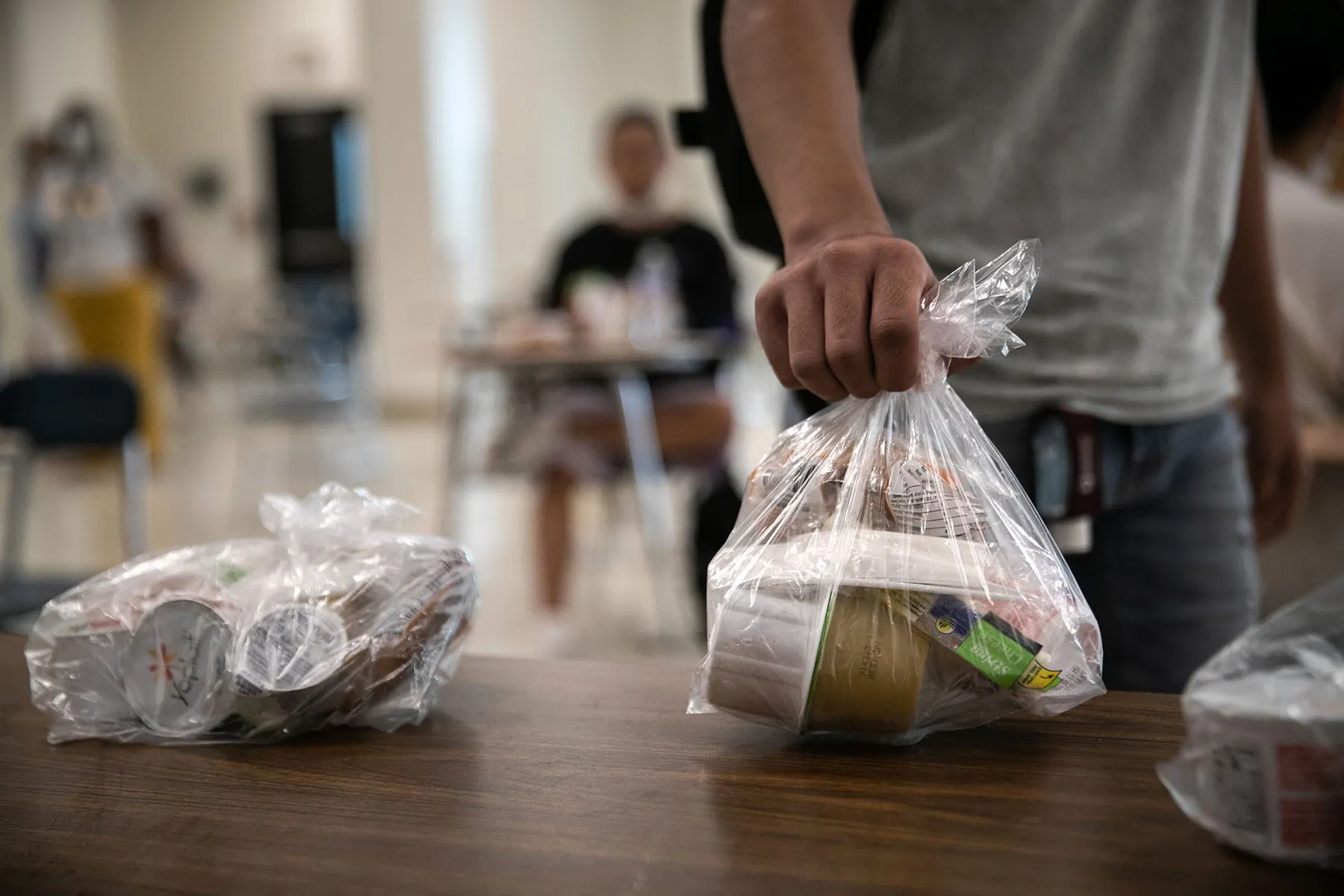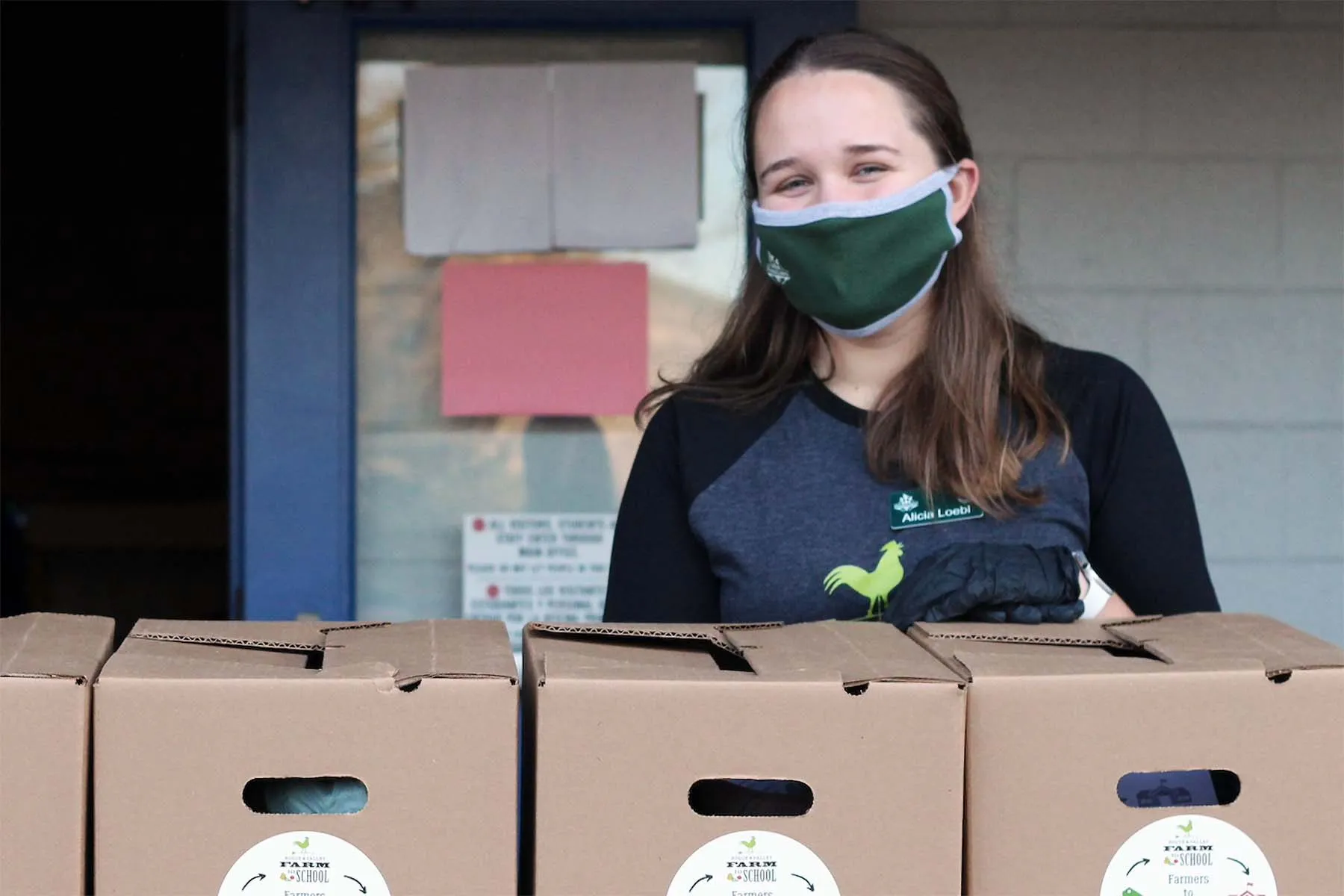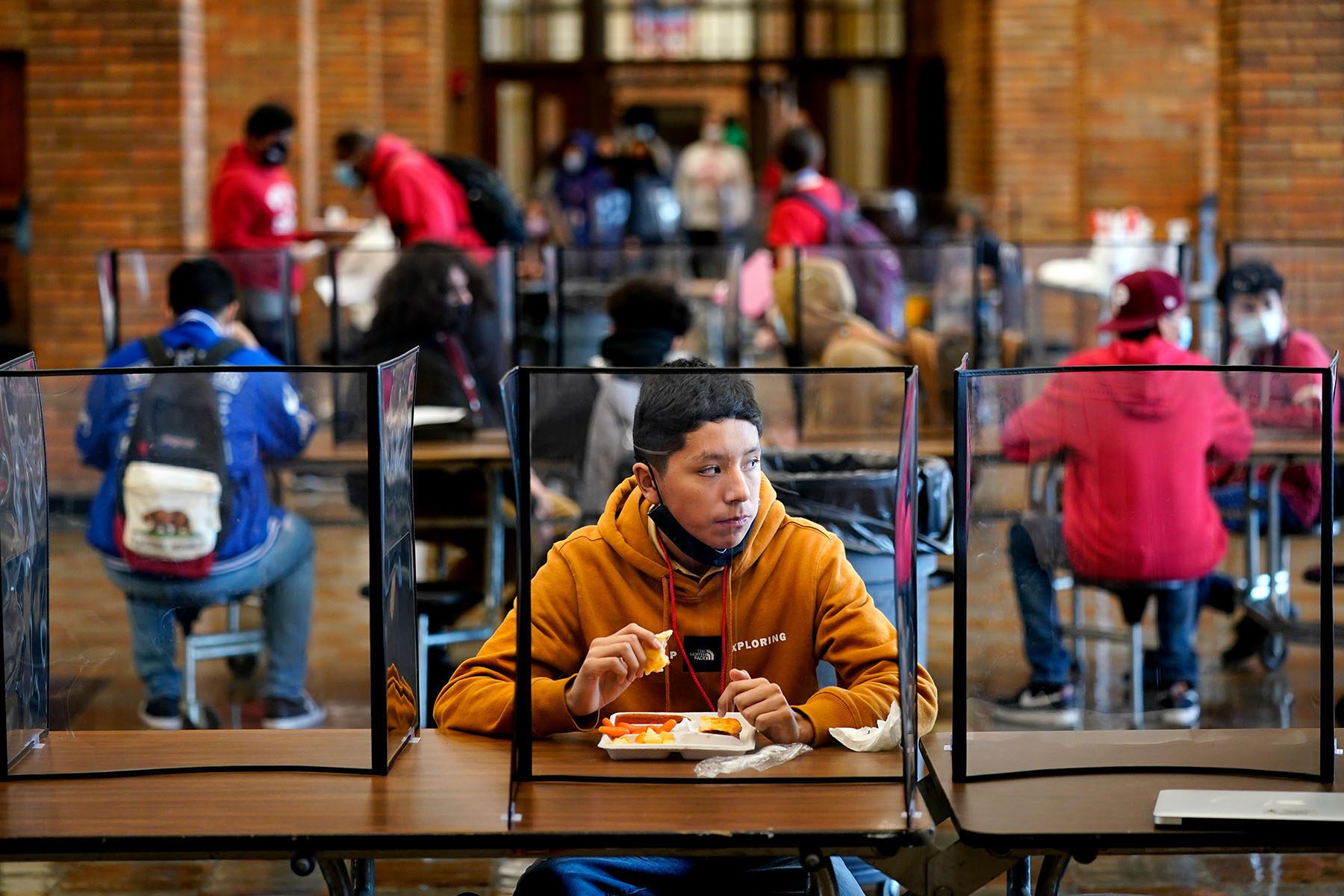Just weeks before COVID-19 forced schools to go virtual, Bertrand Weber set out to increase the plant-based proteins Minneapolis Public Schools (MPS) serves to students. As the award-winning director of the district’s Culinary and Wellness Services, Weber had already overseen a massive makeover of the school lunch program.
Grant funding enabled MPS to build kitchen infrastructure, allowing more than 40 schools in the district to get the equipment needed to make foods and condiments from scratch — from additive-free pasta sauce and salad dressings to deli meats sans nitrates. With the new kitchen tools, the culinary staff also swapped out chicken nuggets with whole chicken and tater tots with actual potatoes.
Given these upgrades, offering a variety of plant-based proteins in cafeterias seemed like a feasible next step for MPS. Then, the novel coronavirus struck, bringing not only the plant-based protein initiative to a halt but forcing the school district to scale back its array of menu options.
During on- and offline instruction over the past 21 months, school districts nationally have faced major challenges while providing meals to students: supply chain disruptions, staffing shortages and COVID-19 safety protocols such as requiring food items to be individually wrapped. Many school districts resorted to serving mainly processed foods, but others have worked to adapt, using creative solutions to get fresh produce and locally sourced food to students.
The U.S. Department of Agriculture said this fall that it would invest $1.5 billion to help schools respond to food supply chain disruptions, and school nutrition advocates are hopeful that funding for school kitchen equipment and healthier school meals in the Build Back Better package under consideration in Congress will help, too. In 2010, the Healthy, Hunger-Free Kids Act led school menu items across the country to become healthier by updating the nutrition standards for meals that schools could be federally reimbursed for serving to students.
Those changes have been key for the nutrition of many low-income kids: More than three-quarters of the 3.2 billion lunches served as part of the National School Lunch Program during the 2020 fiscal year went to economically disadvantaged students eligible for either free or reduced lunch. Children in households headed by women are especially likely to rely on school meals for sustenance, as 60.6 percent of such households experience some degree of food insecurity.
“Schools were serving age-appropriate calorie ranges, reducing sodium, serving more whole grains and a variety of fruits and vegetables,” said Meghan Maroney, senior policy associate for the Center for Science in the Public Interest. “There’s been huge progress made in the last 10, 15 years in school meals, so it hurts that much more that that pandemic has really halted a lot of great work.”
Since the most vulnerable students need school food to maintain a balanced diet, the contents of these meals matters immensely, say school nutrition directors and advocates for healthy school meals. But some districts appear to be struggling to provide fresh food. Photos of “mystery meats” and other unappetizing-looking lunches served in Paterson, New Jersey, schools led a member of Congress to express concern. In response to the outcry over the photos, the school system “developed a six-step corrective action plan to address the poorly prepared meals,” including staff trainings and the formation of a food services advisory committee, a district spokesperson said. After Riverside, California, parents accused their district of serving moldy cheese sandwiches to students, school officials responded by saying that the sandwiches did not have mold on them but that ice crystals formed on the cheese slices when they were defrosted.
“A lot of school districts have relied on individually wrapped items more so than in the past, which I think has led to the perception that maybe school lunch has deteriorated,” Weber said. “But the only reason [for these changes] is the supply chain as well as staffing as well as COVID protocols. Most of my colleagues can’t wait to get back to normal. So, it’s not like, ‘Oh, we’re just going to go back to serving crap food.’ That is not the sentiment out there.”
MPS is a case in point that the new normal won’t be permanent. Many COVID safety protocols have eased, and Weber is excited that the salad bar is expected to return to cafeterias in January. “We’re back to being able to really showcase what we were doing before,” he said. For his school district, that’s largely making food from scratch in the district’s central kitchen.
But when the pandemic led schools to go virtual in March 2020, MPS handed out meal boxes filled entirely with prepackaged foods. “Everything was prepacked — all fruits and vegetables we purchased individually wrapped, and that was really because of COVID concerns with cross contamination,” Weber said.
In April 2021, when the district resumed in-person learning, the culinary staff prepared both from-scratch foods, such as pasta with meat sauce and chili, and prepackaged foods, including burritos, burgers and tamales. But the nutrition standards for meals remained the same as the ones in place before the pandemic, Weber said. And the district, which serves about 31,600 students, maintained its access to fresh vegetables by buying produce from local farmers and then processing and packing them in its central kitchen.
Often, the nutrition staff combined both scratch foods and purchased foods in the same meal. They might buy precooked chicken, for example, but glaze it with sweet-and-sour sauce they made from scratch. The staff prepared all salads, cooked brown rice and steamed vegetables served to students instead of using ready-made versions of these items, Weber said.
Buying locally has helped MPS avoid some of the supply chain issues that other districts have encountered, but one problem it hasn’t managed to skirt is a staffing shortage. Weber said he’s operating with just 60 percent of his culinary staff, and he is not alone. A national survey of 1,368 school meal program directors conducted from May to June 2021 by the School Nutrition Association found that staffing shortages were a concern for 90 percent of them, and nearly all of them were worried about supply chain disruptions.
Many staffers, fearful of contracting COVID-19, left their jobs in 2020, Maroney said. And now, schools can’t compete with employers that can offer food service workers signing bonuses, higher wages and other benefits. Replacing the workers who’ve left hasn’t been easy, according to Weber.
“We work with a temp agency to help us fill positions, and there are basically twice the amount of job openings as there are people,” he said. “When we started this school year, we went back to cooking on site, as we did before, with a more simple menu because we don’t have the staff at the schools.”
Still, Weber said that school cafeterias are slowIy approaching normal once more. By the 2022-23 school year, he predicts that MPS’ menus will be comparable to what they were like before the pandemic — plus, he hopes, more plant-based proteins.
“We had a lot of initiatives that were started, including a huge effort around plant-based initiatives, and all that got interrupted,” Weber said.
For the West New York School District, it’s too soon to predict when school menus will return to normal, said Food Service Director Sal Valenza. Currently, his priority is to ensure that students continue to eat quality meals amid supply chain disruptions that affected his New Jersey school district almost as soon as the pandemic closed schools in March 2020.
“Manufacturers weren’t ready for all the individually wrapped things we needed,” he said. They caught up, quickly making wrapped items and meal kits available, he said, “but there was certainly a little bit of a learning curve in the beginning.”

With schools physically closed but virtually in session, Valenza continued to feed students in the West New York School District, which includes about 8,000 students. Initially, the food service team handed out lunches of sandwiches, fruits and vegetables. From there, the staff gave families meals to cook at home, such as pouches of macaroni and cheese or the ingredients for a chicken teriyaki bowl. At its peak when schools were closed, the district served 15,000 meals a day, seven days a week, up from the roughly 9,000 meals it served on school days pre-pandemic, Valenza said.
The weekend meals included produce boxes and gallons of milk instead of the standard half-pint. Valenza said the district worked with companies that aggregate products from farms in the Tri-State area of New Jersey, New York and Connecticut, a reliable source of produce that did not require them to depend on cross-country shipments delayed by trucker shortages and related problems.
“We were able to use our local guys who were picking the apples up at the farms and bringing them right to us,” Valenza said. “There were no issues with distribution because the supply chain was much shorter. If you can shorten that supply chain and take some of the pieces out, it’s going to be easier for you.”
Valenza also sourced baked goods such as bread, tortillas and empanadas from local vendors. He became a regular customer of a minority-owned business that individually wrapped products for the district. By purchasing about 10,000 items per week from the company, the district prevented it from having to lay off staff during the pandemic.
Asked what advice he would give to school districts that are still struggling because of supply chain delays, Valenza noted that he’s instructed his staff not to serve any food that they wouldn’t feel comfortable with their own children eating. But he also said that it’s unfair to judge a food service team by a viral photo of a school lunch gone bad. He shared how applesauce in a meal kit his school district served spilled out of its package, unbeknownst to the food staff. By the time it was served to a student, the sauce had grown moldy and the kit needed to be discarded.
“You don’t know what that looked like when they got it,” he said. “And maybe it wasn’t so great looking to begin with, but there were some points where we were just trying to get food, and we were happy with what we could get.”
In some cases, nonprofit organizations partnered with schools to help fill gaps when schools went remote. Alicia Loebl, a member of FoodCorps, a national nonprofit that works to connect children to healthy food in schools, had to contend with multiple disasters last year. Most of the elementary students Loebl teaches in Oregon’s Phoenix-Talent School District were displaced by catastrophic fires when classes went virtual during the onset of the COVID-19 crisis. The wildfires resulted in 50 percent of students in the district losing their homes.

Then, Loebl taught virtual gardening and cooking classes to her students and, with local nonprofit Rogue Valley Farm to School, distributed free boxes of excess produce from farmers to students in need because of the pandemic or the wildfires. To date, the Rogue Valley nonprofit has distributed more than 4,000 boxes containing 60,000 pounds of organic produce collectively for Phoenix-Talent families. Local restaurants also provided meals for families displaced by the wildfires.
This fall, as many students remain unhoused, Loebl continues to connect them with hyperlocal food sources so they can maintain a well-balanced diet. Her students recently took a field trip to an area farm where they harvested vegetables, chopped them up and made a soup, an activity in which they were the key components of the supply chain.
“Creating that school-wide culture of health is important,” Loebl said.
In her role as director of research and assessment for the Chef Ann Foundation, Anneliese Tanner helps school districts nationally do just what Phoenix-Talent, West New York and Minneapolis are doing — procure food locally or transition to scratch cooking.
“I think we’ve heard success stories from the districts that we work with that scratch cooking is helping them avoid supply chain issues because they’re not ordering the same products that most other schools are,” Tanner said.
Generally, Tanner continued, scratch cooking tends to cost less, taste better and be higher quality than prepackaged, ready-made foods. These distinctions are especially important for economically disadvantaged children, as “students who most depend on school for their meals deserve the highest nutrition,” she said.
Formerly the executive director of food services and warehouse operations for Austin Independent School District in Texas, Tanner is also an advocate for universal free school lunch. Like other school nutrition professionals who spoke to The 19th, she said that the effort to provide children with free lunches during the pandemic has been a rare highlight in an otherwise trying time for food service teams. The U.S. Department of Agriculture has provided schools with COVID-19 waivers that cover the cost of meals for students through June 2022. This not only ensures that students have equitable access to meals, Tanner said, but also allows school food service departments to maximize revenue because they receive funding for each meal they serve. If more children eat, food service departments get more funding, and they can invest those dollars into making the highest-quality food, she added.
Over the summer, both Maine and California passed legislation to provide free school meals for all students. On average, according to the School Nutrition Association, school lunch costs about $2.48 for elementary school students, $2.68 for middle school students and $2.74 for high school students, while school breakfast costs $1.46, $1.53 and $1.55 for those students, respectively. For low-income parents, especially single mothers of children, the group most likely to be food insecure, these prices can quickly add up. And many families, even if eligible for free or reduced lunch, don’t apply for them because they don’t complete the paperwork needed or hesitate to accept “handouts.” Universal free lunch is likely to remove the stigma associated with needing a free school meal, nutrition advocates argue.
Free lunch, Valenza said, shouldn’t just be a temporary policy to help struggling families during the pandemic but a lasting change well beyond the coronavirus crisis.
“The fact that we’re doing universal lunch right now is great,” Valenza said. “I’m hoping it’s something that’s going to continue because we pay for busing, we pay for books — why do we not pay for the meals these kids need to be able to learn? I’m hoping everyone’s seen the value of what school nutrition does, the value of the meals that we serve and the way that we’re able to be a huge tool in combating food insecurity.”
Correction: An earlier version of this article incorrectly stated the percentage of students in Oregon's Phoenix-Talent School District who lost their homes to fires.





